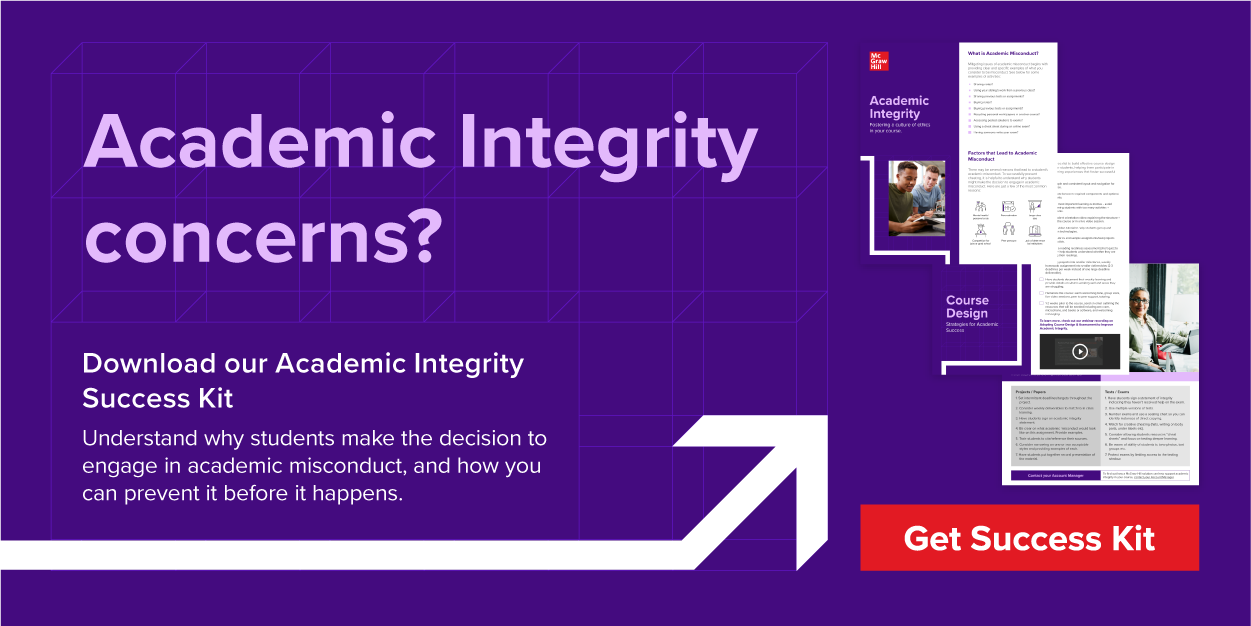5 Ways to Identify Academic Dishonesty
When students try to get an unfair advantage in your course, instructors can end up feeling disheartened and pessimistic. Many times, this is labeled specifically as cheating. More specifically, it is defined as intentionally using or attempting to use unauthorized materials in any academic exercise. Academic dishonesty can also be known as plagiarism, the use of another individual’s results, ideas, or words without giving the correct credit. However, no matter the word used, it is simply an act of fabrication and dishonesty. Read on to help you identify any scenarios where academic dishonesty may have occurred.
1. Know Your Institution’s Policies and Be Transparent with Students
Whether you’re a new instructor, take on a more extensive role at your current institution, or just looking to implement changes to your course, you need to make yourself familiar with your institution’s policies and rules in regard to academic integrity and creating an equitable classroom environment. It is critical that students know the expectations and rules for your course. Some things to consider are:
- What procedures and rules do you want to have for assignments and exams?
- Do you want your students to work on homework with their peers?
- Spell out all parameters and what you consider cheating or plagiarism and define consequences.
Make sure you outline this information from day one. If one of your students performs an act of academic dishonesty, you will then be able to enforce the sanctions in the correct way.
2. Understand the Methods Students Use to Plagiarize and Cheat
Students cheat for many reasons. However, the way they cheat has changed drastically over the years. Usually, people assume that students who cheat are bad or failing students – but this is not necessarily the case. Some of the reasons students may cheat include:
- Anxiety
- Stress
- Poor time management skills
- Tough class schedules
- Poor communication skills
Here are some cheating methods you will need to keep an eye out for:
- Smartphones- Many students take pictures of their answers and send them to their friends via text.
- Social Media Communications- Students may discuss test questions via social media to give their friends academic advantages.
- Groups that Share Tests- Many student groups will have tests and assignments from previous years that allow students to cheat.
- Smartwatches- Smartwatches now allow communication and internet browsing without a smartphone.
- Unauthorized Help- Some tutoring services allow students to write the perfect paper or beat a test with unauthorized aid.
Being smart and aware of these methods can allow you to identify when they are being used improperly.
3. Be Proactive, Not Just Reactive
When it comes to academic dishonesty, sometimes the issue can come back to the faculty member for not being proactive. For example, you may need to vary your assessments in type and questions from term to term so they are less predictable and therefore less likely to be distributed. It can also be helpful to establish your stance on academic misconduct early on in the term so your students know what to expect, and what you expect of them.
4. Grade Reports, Assignments, and Essays Attentively
Many times, you need to trust your gut when looking for possible academic dishonesty. When grading assignments, if you notice that a particular student’s work is far too advanced for their level, this can show strong proof of plagiarism. Here are some ways to avoid this:
- Ask your students to show their work by providing multiple drafts.
- Grade papers side-by-side as direct copying may be more apparent if they have worked in a group or with a partner.
- Require students to upload their assignments through online plagiarism checkers to help you identify any misconduct.
5. Manage Exam Administration and Proctoring
Most of the time, attention of focused on deterring cheating during the exam itself. Here are some methods that can help prevent academic dishonesty during an exam:
- Ask your students to show their work by providing multiple drafts.
- Assign seats so that friends and study partners can’t sit next to each other.
- Having multiple forms of the same exam can help to prevent cheating as it can promote an honest testing environment.
Proctoring is also of the utmost importance when it comes to exams. In a small classroom, there is only sometimes one adult teaching a large 20-40 student class. Teaching assistants and faculty should work together to make sure that students are honestly taking their exams.
Proctors can create an honest environment by doing the following things:
- Many proctors will give the exam papers out and then become distracted by grading other assignments, browsing on their cellphone, or sitting on their computers. After the exams have been passed out, you should walk around to ensure that everyone is being honest.
- Reminding the students about looking at their own papers can help so much. Having another set of eyes can help you correct the behavior in time.
- Make sure to meet with other proctors/faculty members before the exam to explain all of the correct protocols and previous experiences. This can help anyone during a situation they have never experienced.
While academic dishonesty can cause a lot of frustration, giving your students an objective assignment and fair testing environments is the ideal goal for all successful educators.


